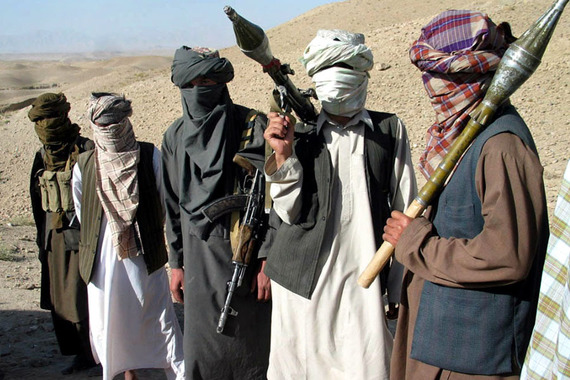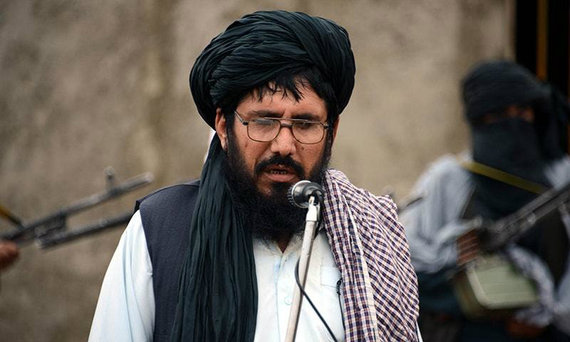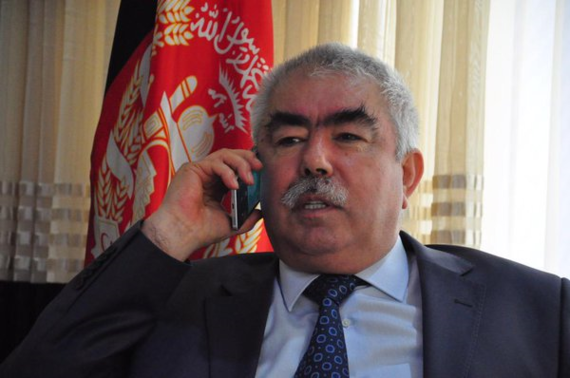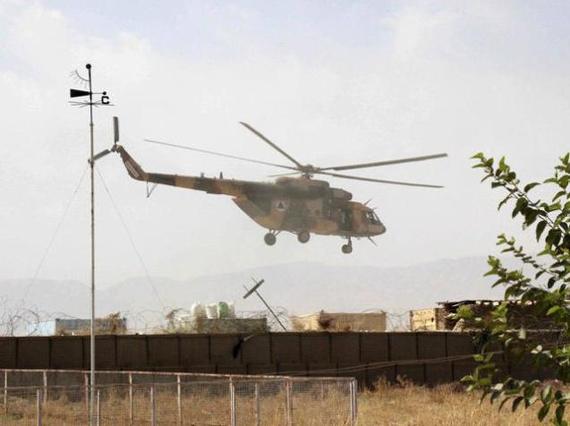On November 30, 2015, the U.S. Embassy in Kabul Afghanistan issued a warning that it had received reliable information that an attack on Kabul was imminent within the next 48 hours. Exactly what the nature of that "attack" was going to be, however, was not specified. Was it going to be another, this time more extensive, round of bombings or was it going to be a broader campaign to take control of the city itself? On December 11th, Taliban militants did attack the Spanish Embassy in Kabul killing a Spanish policeman and an officer at the embassy. In addition four Afghan policeman and a foreign civilian were killed in the fighting. It's unclear whether the U.S. embassy warning was referencing the attack on the Spanish embassy or some other planned campaign.
The warning came only weeks after Taliban forces had seized and temporarily held the northern city of Kunduz; the first time they had controlled a city since 2001. It followed a number of largely unsuccessful but persistent Taliban attacks in Kabul over the summer and fall. These attacks included a car bomb attack against NATO forces in central Kabul on October 11, an attack on an Afghan intelligence center in the western area of the Afghan capital on October 5, a series of bombings on August 7 and 8 against an Afghan army base in the Shah Shaheed residential district and a suicide bombing at the Kabul Police Academy that killed 20 cadets.
Over the first half of the year, civilian casualties in Afghanistan reached a record high of 3,329, up four percent from the comparable period in 2014, although fatalities had fallen to 1,592, a decline of six percent.
On October 15, the Obama Administration announced that it was halting further troop reductions from Afghanistan and that the current deployment would continue thought 2017. The announcement quelled widespread speculation that a complete U.S. and NATO withdrawal was imminent. Originally, the White House had promised that all American troops would be out of Afghanistan by 2014.
The warning, coupled with the continued incidents of violence, reinforced the widely held belief that the Taliban is continuing to gain strength in Afghanistan. This perception has been steadily increasing since 2006 and has become more widespread as U.S. and NATO troops have steadily withdrawn from forward operating bases throughout Afghanistan.
The conventional wisdom is that when U.S. and NATO troops are eventually withdrawn, the Taliban will be able to retake control of Afghanistan. The U.S. decision to extend the American deployment is thus only a short respite, putting off for a few more years the inevitable return of the Taliban. While the Taliban's return to power is not out of the question, there are a number of factors that make such a return extremely difficult, if not unlikely.
First of all, there has been growing evidence that the Taliban leadership is badly split into two mutually antagonistic groups. On July 30, a Taliban spokesman had confirmed that the group's leader since 1994, Mullah Mohammad Omar, died in April 2013 from an unspecified illness in a Karachi hospital and that the Taliban Leadership Council in Pakistan, the Quetta Shura, had appointed Omar's deputy, Mullah Akhtar Mansoor, to head the movement and had officially designated him as the Amir Ul Mumineen, the "commander of the faithful." The same position claimed by the head of Islamic State, al-Baghdadi. The announcement came in response to an Afghan government announcement that it was preparing to release credible evidence that Mullah Omar had been dead for at least two years.
Mansour was a member of the Taliban government that ruled Afghanistan from 1996 to 2001 where he served as aviation minister. He had fought alongside Omar as part of the original anti-Soviet mujahedeen in the 1980s and had been part of the Taliban movement and its core leadership from the very beginning. Mansour, however, lacks the prestige of Mullah Omar. Indeed, the official announcement of Omar's death and Mansour's appointment as his replacement sparked widespread resentment within the Taliban when it became clear that Mansour had effectively been issuing orders in Mullah Omar's name for the previous two years while the knowledge of Omar's death was kept secret from the rest of the Taliban rank and file.
Moreover, in the weeks following Mansour's appointment, reports began to circulate that Mullah Omar's death had been orchestrated by the Pakistani Inter-Services Intelligence agency and that it had been carried out by Mullah Mansour himself. Officially the Taliban had claimed that Omar died a natural death, only later disclosing that it had been as a result of a long-running battle with Hepatitis C.
It's unclear to what extent these reports were true or whether they were misinformation orchestrated by the National Directorate of Security (NDS), the Afghani intelligence agency. In any case, a competing leadership group drawn from Mullah Omar's family and other close associates declared that they would not accept Mansour's leadership. Chief among them was Mullah Abdul Manan, Omar's brother, Mullah Mohammad Yacoub, Omar's eldest son, and Mullah Mohammad Rasool Akhund, a longtime friend of Omar.
On September 15, a statement on the Taliban's Voice of Jihad, its official website, claimed that Mullahs Akhund and Yacoub had both agreed to swear loyalty to Mansour. On November 2, however, this same faction of the Taliban announced that they had rejected Mansour's leadership and had appointed Akhund as their leader, bestowing on him, in direct competition with Mansour, the title of Amir Ul Mumineen.
During the Taliban years in power, Akhund had been governor of Nimroz province and during the period of insurgency he had functioned as the "shadow governor" of Farah province. Both provinces, in the extreme southwest of Afghanistan, are part of the Taliban's historic power base. Akhund in turn appointed Mullah Mansour Dadullah, a well-known Taliban military commander and longstanding rival of Mansour, as one of his military deputies. Since then open fighting has erupted between the two groups.
Since November 9, approximately 80 Taliban fighters loyal to Akhund's faction, possibly including Mansour Dadullah, have been killed in clashes with pro-Mansour Taliban fighters. On December 2, Afghan government sources claimed that the Taliban leader Mullah Mansour had been injured, possibly fatally, in a firefight that had erupted during a meeting of Taliban commanders in Kucklah, Pakistan.
The Taliban subsequently denied the report claiming that they had been planted by the NDS. On December 4, the Afghan government issued a second statement claiming that Mullah Mansour had died as a result of the injuries suffered in the alleged firefight. On December 6, the Taliban issued an audiotape purported to be from Mansour in which he expressed his condolences to those who had been killed in the firefight but claiming he was still very much alive.
Interestingly enough both Afghan government sources and a number of Taliban leaders expressed doubt about the authenticity of the recording. For the moment, at least, it appears that the divisions within the Taliban are substantial and that the movement is badly split. It is unclear whether Mansour is still alive or what impact his possible death may have on those divisions.
There have been "splits" in the Taliban before, typically between so called "moderates" that were open to a reconciliation with the Afghan government and "hardliners" that were determined to continue fighting. It's possible that such "splits" were "manufactured" by the Pakistani Inter-Services Intelligence directorate (ISI) in an attempt to manipulate American perceptions of the Taliban and to encourage an American withdrawal. The most recent "split" may be a case of the same, although this time it seems more genuine.
In addition to the split in the Taliban, the strategic landscape in Afghanistan is completely different in 2015 than it was in 1996 when the Taliban first came to power. First of all, in 1996 there was no central government. The Najibullah government had collapsed in 1992 and Afghanistan spent the following four years sliding deeper into a state of anarchy. The countryside was dominated by warlords who had no political legitimacy and who ruthlessly exploited the villages they controlled.
Internationally, Afghanistan wasn't drawing much attention from any of the major powers. The U.S. had withdrawn from the region following the withdrawal of Soviet troops in 1989 and the subsequent unravelling of the Afghan government. Russia, in 1996, seven years after the collapse of the Soviet Union, was in a state of disarray and was hardly in a position to exert significant influence much less lend meaningful support to any potential allies in Afghanistan.
India and Iran, especially the latter, were interested bystanders. Iran had long standing interests in Afghanistan given its historic ties to the Shia Hazari people of western Afghanistan. Moreover, the chaos in Afghanistan had resulted in almost three million Afghan refugees in Iran. Tehran too had a vested interest in seeing some semblance of order brought to Afghanistan even if it wasn't in a very strong position to impose its preferred solution. India gave some aid to the Northern Alliance, but otherwise was not actively involved. In these circumstances, Pakistan's ISI had a relatively free hand to organized and direct the Taliban movement and orchestrate their rise to power in Afghanistan.
If the United States and NATO forces withdraw from Afghanistan, it is very likely that Russia will return to its traditional role as the Afghan government's principal sponsor. Already, the Kabul government has asked Moscow for additional military aid and Moscow has agreed to sell Afghanistan an unknown number of Mi-35 attack helicopters. In addition, Russia has in recent years emerged as the principal supporter of the Tajik centered Northern Alliance and it has long standing ties to Afghan vice president Abdul Rashid Dostum, a Tajik and also a former general in the Northern Alliance.
According to unconfirmed reports, current Russian financial and military aid to the Northern Alliance amounts to about 200 million dollars a year. It is no coincidence that the Northern Alliance militias are sporting brand new Ak-47s. In addition, Russia has deployed air forces at its former Ayni air base in Tajikistan, close to the Afghan border, allowing it to provide air support for the Northern Alliance and to a lesser extent, if need be, Afghan government forces elsewhere in the country.
India had provided some support to the Northern Alliance and had operated a military hospital at the former Soviet air base in Farkhor, on the Afghan-Tajikistan border during the 1990s. More recently, it also paid for the modernization of both the Ayni and Farkhor air bases. There have been persistent reports that the Indian government is interested in stationing Indian air forces at either of the two air bases, but has consistently been blocked by Moscow from doing so.
Iran has long-standing ties to the Shia Hazara people of western Afghanistan that stretch back centuries. Moreover, there are long standing frictions between Afghan Pashtun's and the Hazara. The latter were subject to intense Pashtunization campaigns during the 20th century and were forcefully urbanized. Large numbers of Hazara refugees escaped to Iran during the Taliban years. Iran has funded Shia mosques, universities, TV stations and charities in Afghanistan with particular attention to the Hazara communities. Many Hazara leaders have been educated in Iran and have sought refuge there from time-to-time.
Iran has organized and trained Hazara militias, some of which are currently deployed in Syria in support of the Assad regime, and that could be redeployed to Afghanistan in the event of an imminent Taliban takeover. Notwithstanding these close ties, however, the Hazara community is politically and ethnically complex with significant differences between educated, Western oriented, urban Hazaras and their uneducated rural brethren. It would be a mistake to see them solely as Iranian proxies.
In addition, Iran has historically supported the Tajiks of the Northern Alliance against the Taliban, even though they were predominantly Sunni, and would be expected to do so again, this time more forcefully, in the event of an attempted Taliban takeover.
Pakistan's future role in Afghanistan is a complex and an uncertain one. Since 1994, the Taliban has been Pakistan's principal vehicle for exerting its influence in Afghanistan. Pakistani funding, safe havens and support have been critical both to the rise of the Taliban to power in Afghanistan and for their continued survival since 2001.
During the American and NATO led intervention that began in 2001, Pakistan has been officially supporting the U.S. led operation, been fighting the Taliban related Tehrik-i-Taliban Pakistan insurgency in the Federally Administered Tribal Areas (FATA), while at the same time providing assistance to the Afghan Taliban, as well as al-Qaeda militants hiding in Pakistan.
In recent months there have been persistent reports from Kabul that Pakistan's ISI has been involved with organizing the Islamic State affiliate in Afghanistan and may have tried to facilitate the migration of Taliban supporters to that jihadist organization. Sources in the Afghan government believe that the ISI may be laying the groundwork to use the Afghan Islamic State affiliate to advance its objectives in Afghanistan should the Taliban organization disintegrate or ultimately look to reach a peace agreement with the Kabul government.
Although the withdrawal of NATO forces from many of their forward operating bases have increased the ability of the Taliban to project its force into the rural areas, the Taliban remains deeply unpopular in the cities. Currently, the Taliban has the ability to exert considerable force in some 40% of Afghanistan, virtually all of it in rural areas. It has the ability to stage attacks in the major cities but it lacks the ability to take or hold the major cities.
It does have considerable financial resources available to it and has an annual budget believed to be in excess of two billion dollars with which, among other things, to bribe or suborn its opponents. The impression of its rising power notwithstanding, however, it is still a very long way from re-exerting the degree of control over Afghanistan that it had in 2001. As long as the U.S. and NATO forces remain in Afghanistan it is unlikely that it can reassert that position. Even if U.S. and NATO forces were to completely withdraw, Russian, Iranian and Indian supported proxies would prove to be a considerable obstacle to its return to power in Kabul.
In that sense the Taliban raid on the city of Kunduz must be seen not as the start of a new Taliban campaign to assert its control over the major cities but rather as an attempt to underscore its continued relevance in Afghanistan and more importantly to legitimatize the role of Mullah Mansour as the leader of the organization.
According to Afghan sources, the Taliban spent millions of dollars in bribes to local elected officials and senior military officers to ensure that they would be conveniently absent during the time of the attack in order to ensure its success even though they had no expectation that they would be able to hold the city over the long-term.
The entire attacking force is believed to have been approximately 900 men, most of whom were not active Taliban militants, but locally recruited free agents. Raising a temporary army in rural Afghanistan is not difficult. Virtually everyone in rural areas is armed. A couple of hundred thousand dollars and the prospect of a little loot on the side will get you the services of 500 to 1,000 fighters for two to four weeks. Ammunition is extra.
The choice of Kunduz was also symbolic. The city lies across the key transportation route connecting central Asia with the Arabian Sea to the south and with the Punjab plain and the Indian subcontinent to the southeast. According to Afghan intelligence sources, Mullah Mansour had been scheduled to make an appearance in Kunduz following the Taliban takeover of the city but was unable to do so when his convoy ran into unexpected roadblocks.
The attack was little more than an expensive PR stunt. Its purpose was simply to set the stage for Mullah Mansour's public debut and in the process remind the rest of the world that the Taliban is still relevant.
It is still too early to dismiss the Taliban in the future of Afghanistan but neither is its success or a return to its previous position of power the foregone conclusion that many believe it is. For now the situation remains fluid and the future of the Taliban and of Afghanistan continues to remain in flux.




